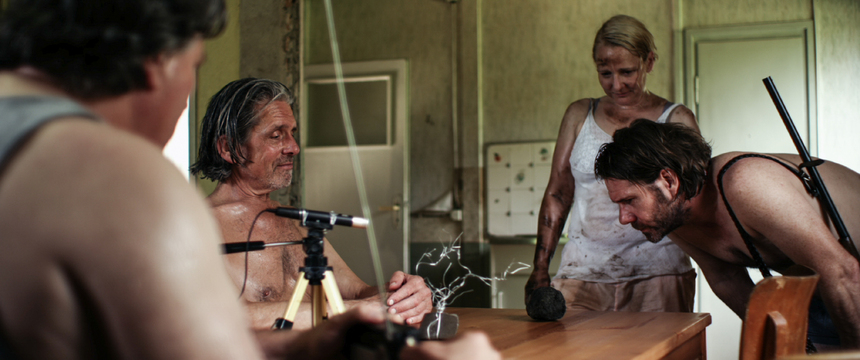Slamdance 2017 Review: WEATHER HOUSE Roofs Absurdism and Minimalism For Timely Allegory
Frauke Havemann and Eric Schefter's absurdist film is a no-nonsense nonsenical treatise on objective reality

The initial setup of Weather House, the directorial feature debut by Frauke Havemann (co-directed by Erik Schefter) remains basic throughout the whole duration of the film. A group of people whose relations are not disclosed and who could easily be strangers reside in a derelict and abandoned house. And it does not look like a voluntary stay over. Intertitles informing about actual climate situations, such as inside and outside temperature changes, appear periodically as if to explain the bizarre occurrences taking place in the house.
The archetypal characters are defined by their expertise or self-assigned task they keep performing. The leader seems to be an engineer who constructs a network of wires inside the house recalling more an eccentric conceptual sculpture rather than something of pragmatic value. A woman obsessively records all the sounds and never talks while another man religiously tinkers with a small radio and is occasionally spotted outside the house with a giant antenna mounted on his back. He is also tied to a plant that enjoys almost equal screen-time as its human companions. Meanwhile, sadistic instincts awaken in a lady that is usually indifferent.
The film´s title refers to a folk tradition of building tiny houses where figurines emerge following changes of weather conditions. Blown up into a life-size scale, the concept resembles more a perverse psycho-social experiment where outer factors derail the usually normal behavior of the test group. Ill-fitted for such a situation and left without any scientific tools at hand while relying solely on one´s mind, the result makes for a spectacle reminiscent of Artaud's Theatre of Cruelty.
Frauke Havemann´s previous experience working on film, video installations and performance, synergistically converge in Weather House, firmly molding the film´s style. Havemann´s oeuvre cleverly assimilates civil horror and somewhat latent irony. The final blend gravitates suspiciously close to the poetics of the theatre of absurd. And that´s only for the benefit of the whole project. The approach does not feel outdated, on the contrary, Havemann and Schefter reinvigorate it with modern filmmaking.
Entrapped inside a claustrophobic space with only a limited inventory, Weather House features a bizarre (psycho) robinsonade. However, the interior shots are frequently interrupted by various close-ups of nature phenomena stylized with menacing fervor. Even due to these uncompromising juxtapositions and ideas they consequently yield, Weather House expands further beyond an environmentalist elegy. Nevertheless, Havemann´s composition, tinkering with videoart sensibilities and deadpan staging bypass the obvious and provokes a deeper introspection achieved through artistic minimalism and mystery.
It does not take long for Havemann and Schefter's effort to conjure up the ghost of Luis Bunuel´s The Exterminating Angel although the directors and the screenwriter Mark Jonhson build less satirical counterpoint to the surrealist maestro´s oeuvre. As the plot progresses and more strangers appear, some of them turning up as corpses, the editing of interior versus exterior shots invokes a tension between the scenes as well as in the group dynamics.
The vague and cryptic references to the proceedings outside the four walls fuel the tension and helps to spotlight shadowy nooks and crannies of a viewer's mind. Given the rather enigmatic character of Weather House and the premise of finding refuge against the outer world suggests a setting of a pre-/post-apocalyptic event driving strangers to form a ragtag group of survivors. The encapsulation of the story into a Schrodinger´s cage of cataclysm gives Weather House wider allegorical meaning.
Furthermore, the menacing atmosphere, confusion, hints about dead bodies in the house, a sudden appearance of a shooter gazing through a window ready to act and the apocalyptic vibe bring to mind the exceptional novel by American scribe Cormac McCarthy, The Road.
Eventually, Weather House could easily represent a cross-over between The Exterminating Angel and The Road being staged as Ionesco or Genet´s play. Havemann states regarding the film that “nature is indifferent to human presence. Nature prevails.” thus making Mother Nature a powerful entity unamused by humankind´s plight and perfectly immune to any attempts of being controlled or tamed. The director´s statement erases the supposed eco theme and supersedes it with a purely existentialist one.
Even though the idea of Nature manipulating or gravely endangering humankind on a whim unfolds an overwhelming layer of existentialism and insignificance of human beings, the timing of the film might suggest an eerie parallel to the actual state of affairs of the so-called post-factum world without that big of a stretch of the imagination.
The synopsis offers a lead: “Set in an unspecific time of extreme climate change, an isolated group of disoriented characters develop their own strange belief systems and engage in absurd activities to process their dilemma”.
Although interpretation remains open, the allegory about vanished objective reality succeeded by more mercurial conditions and the struggle of individual perspectives to grasp it emerges. The air of impending menace and impotency to overcome it takes a rather grotesque shape in Weather House. Havemann and Schefter accomplish a no-nonsense achievement despite the fact that nonsense wields a defining function in the film.







